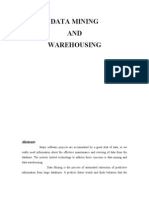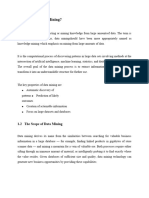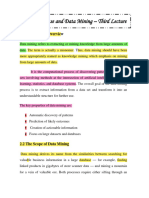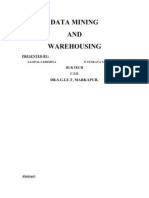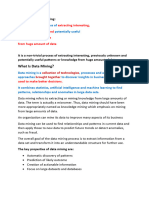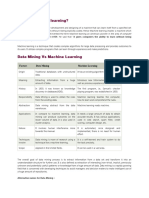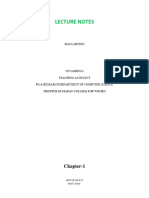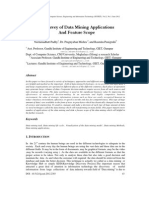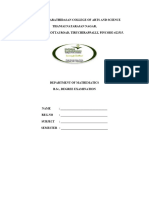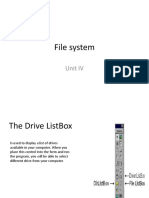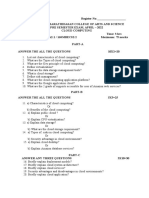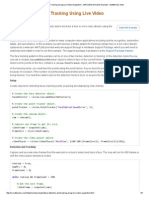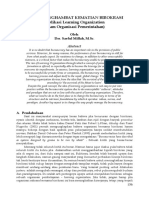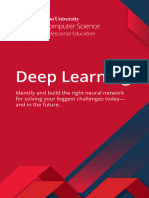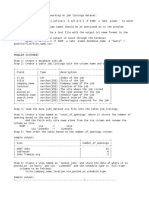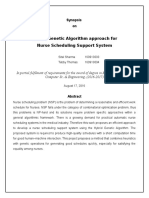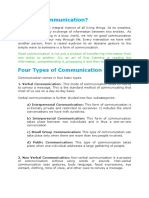Testdocu
Testdocu
Uploaded by
bagya lakshmiCopyright:
Available Formats
Testdocu
Testdocu
Uploaded by
bagya lakshmiOriginal Title
Copyright
Available Formats
Share this document
Did you find this document useful?
Is this content inappropriate?
Copyright:
Available Formats
Testdocu
Testdocu
Uploaded by
bagya lakshmiCopyright:
Available Formats
Abstract
Data mining is a process which finds useful patterns from large amount of data. The paper discusses few of the data mining
techniques, algorithms and some of the organizations which have adapted data mining technology to improve their businesses and
found excellent results.
Keywords: Data mining Techniques; Data mining algorithms; Data mining applications.
1. Overview of Data Mining
The development of Information Technology has generated large amount of databases and huge data in
various areas. The research in databases and information technology has given rise to an approach to store
and manipulate this precious data for further decision making. Data mining is a process of extraction of
useful information and patterns from huge data. It is also called as knowledge discovery process,
knowledge mining from data, knowledge extraction or data /pattern analysis.
Figure 1. Knowledge discovery Process
Data mining is a logical process that is used to search through large amount of data in order to find
useful data. The goal of this technique is to find patterns that were previously unknown. Once these
patterns are found they can further be used to make certain decisions for development of their businesses.
Three steps involved are
Exploration
Pattern identification
Deployment
Exploration: In the first step of data exploration data is cleaned and transformed into another form, and
important variables and then nature of data based on the problem are determined.
Pattern Identification: Once data is explored, refined and defined for the specific variables the second step
is to form pattern identification. Identify and choose the patterns which make the best prediction.
Deployment: Patterns are deployed for desired outcome.
2. Data Mining Algorithms and Techniques
Various algorithms and techniques like Classification, Clustering, Regression, Artificial
Intelligence, Neural Networks, Association Rules, Decision Trees, Genetic Algorithm, Nearest Neighbor
method etc., are used for knowledge discovery from databases.
2.1. Classification
Classification is the most commonly applied data mining technique, which employs a set of pre-classified
examples to develop a model that can classify the population of records at large. Fraud detection and creditrisk
applications are particularly well suited to this type of analysis. This approach frequently employs
decision tree or neural network-based classification algorithms. The data classification process involves
learning and classification. In Learning the training data are analyzed by classification algorithm. In
classification test data are used to estimate the accuracy of the classification rules. If the accuracy is
acceptable the rules can be applied to the new data tuples. For a fraud detection application, this would
include complete records of both fraudulent and valid activities determined on a record-by-record basis.
The classifier-training algorithm uses these pre-classified examples to determine the set of parameters
required for proper discrimination. The algorithm then encodes these parameters into a model called a
classifier.
Types of classification models:
Classification by decision tree induction
Bayesian Classification
Neural Networks
Support Vector Machines (SVM)
Classification Based on Associations
You might also like
- The Theoretical and Practical Relevance of Simple CodesDocument8 pagesThe Theoretical and Practical Relevance of Simple CodesDona ArtaNo ratings yet
- Feedback Control of Dynamic Systems 2008Document132 pagesFeedback Control of Dynamic Systems 2008Ju-Suk Yang83% (6)
- Data Mining ImplementationDocument9 pagesData Mining Implementationakhmad faiz al khairiNo ratings yet
- Data Mining Techniques and ApplicationsDocument16 pagesData Mining Techniques and Applicationslokesh KoppanathiNo ratings yet
- Data Mining AND Warehousing: AbstractDocument12 pagesData Mining AND Warehousing: AbstractSanthosh AnuhyaNo ratings yet
- DM Module1Document15 pagesDM Module1Shubhi SrivastavaNo ratings yet
- DMDW Lecture NotesDocument24 pagesDMDW Lecture Notessunandan RanaNo ratings yet
- Unit 3Document34 pagesUnit 3varsha.j2177No ratings yet
- Unit 4 New Database Applications and Environments: by Bhupendra Singh SaudDocument14 pagesUnit 4 New Database Applications and Environments: by Bhupendra Singh SaudAnoo ShresthaNo ratings yet
- Lecture 1428550844Document87 pagesLecture 1428550844mamithasuyambuNo ratings yet
- Applying Data Mining Techniques in Property Casualty InsuranceDocument25 pagesApplying Data Mining Techniques in Property Casualty InsuranceHadyan WidyadhanaNo ratings yet
- Data Mining NotesDocument75 pagesData Mining NotesAravind RossiNo ratings yet
- Data Mining NotesDocument82 pagesData Mining Notesamartya1820No ratings yet
- Data Mining Chapter 1Document12 pagesData Mining Chapter 1Rony saha0% (1)
- Data Mining Concepts and Applications: Six Factors Behind The Sudden Rise in Popularity of Data MiningDocument36 pagesData Mining Concepts and Applications: Six Factors Behind The Sudden Rise in Popularity of Data MiningOngudi TiberiusNo ratings yet
- LECTURE NOTES ON DATA MINING and DATA WADocument84 pagesLECTURE NOTES ON DATA MINING and DATA WAAli AzfarNo ratings yet
- DM Notes-1Document71 pagesDM Notes-1Dheeraj KumarNo ratings yet
- Unit-1 Introduction To Data MiningDocument33 pagesUnit-1 Introduction To Data Miningzeeshaan7290No ratings yet
- Lecture 3Document10 pagesLecture 3mohammed.riad.bi.2020No ratings yet
- MiningDocument7 pagesMiningdesaimohitNo ratings yet
- Sathyapriya Thesis NEWDocument47 pagesSathyapriya Thesis NEWMukesh LavanNo ratings yet
- Data Mining - Digital Notes (Unit I To V)Document85 pagesData Mining - Digital Notes (Unit I To V)VijayNo ratings yet
- Data Mining and Data WarehousingDocument25 pagesData Mining and Data WarehousingObiwusi KolawoleNo ratings yet
- Data ScienceDocument11 pagesData Sciencedeepti.u.1228No ratings yet
- Assignment 2nd DMDWDocument11 pagesAssignment 2nd DMDWanguralrakesh80No ratings yet
- Whats AppDocument23 pagesWhats AppRâjä SékhãrNo ratings yet
- 1.1what Is Data Mining?: GallopDocument64 pages1.1what Is Data Mining?: GallopNelli HarshithaNo ratings yet
- Unit II Data MiningDocument8 pagesUnit II Data MiningAjit RautNo ratings yet
- DM - Weka ReprotDocument18 pagesDM - Weka ReprotMR. SIDDHESH KATHALENo ratings yet
- Unit 1Document27 pagesUnit 1bhavanabhoomika1234No ratings yet
- Data Mining and Its Techniques: A Review Paper: Maria Shoukat (MS Student)Document7 pagesData Mining and Its Techniques: A Review Paper: Maria Shoukat (MS Student)mariashoukatNo ratings yet
- Data Warehousing&Dat MiningDocument12 pagesData Warehousing&Dat MiningKattineni ChaitanyaNo ratings yet
- NotesDocument30 pagesNotesSaurabh KansaraNo ratings yet
- Datamining With Big Data - SivaDocument69 pagesDatamining With Big Data - SivaVenkatesh GardasNo ratings yet
- Data MiningDocument11 pagesData MiningRahul KalyankarNo ratings yet
- assignment_solutionDocument27 pagesassignment_solutionMADHUSUDAN ChauhanNo ratings yet
- Data MiningDocument3 pagesData Mininghadnica2No ratings yet
- 5 Data Mining Proccess and Techniques - Week 7Document61 pages5 Data Mining Proccess and Techniques - Week 7luluaftimos1308No ratings yet
- Business Uses of Data Mining and Data Warehousing MIS 304 Section 04 CRN-41595Document23 pagesBusiness Uses of Data Mining and Data Warehousing MIS 304 Section 04 CRN-41595Mohit SharmaNo ratings yet
- What Is Data MiningDocument8 pagesWhat Is Data MiningAmran AnwarNo ratings yet
- Fundamentals of DatascienceDocument80 pagesFundamentals of DatascienceProfessorNo ratings yet
- P Veerabathiran ComputerscienceDocument48 pagesP Veerabathiran ComputerscienceDhilsanth SLNo ratings yet
- Data Mining - KTUweb PDFDocument82 pagesData Mining - KTUweb PDFHari krishnaNo ratings yet
- Data Structures: Notes For Lecture 12 Introduction To Data Mining by Samaher Hussein AliDocument4 pagesData Structures: Notes For Lecture 12 Introduction To Data Mining by Samaher Hussein Alisamaher husseinNo ratings yet
- Data Mining Process 1Document4 pagesData Mining Process 1manojNo ratings yet
- 1 - Introduction To Data ScienceDocument6 pages1 - Introduction To Data ScienceDaniel VasconcellosNo ratings yet
- Applying Data Mining in Prediction and Classification of Urban TrafficDocument5 pagesApplying Data Mining in Prediction and Classification of Urban TrafficgraviphotonNo ratings yet
- Delhi Technological University: Dbms Innovative ProjectDocument4 pagesDelhi Technological University: Dbms Innovative Project2K19/CO/408 TATHAGATNo ratings yet
- Data Mining - PrashantDocument10 pagesData Mining - PrashantKunal KubalNo ratings yet
- 1.1 Data and Information MiningDocument24 pages1.1 Data and Information MiningjeronNo ratings yet
- A Novel Methodology For Discrimination Prevention in Data MiningDocument21 pagesA Novel Methodology For Discrimination Prevention in Data MiningArnav GudduNo ratings yet
- Data Mining NotesDocument14 pagesData Mining Notesrishikeshgondcool5No ratings yet
- Data Mining: Prof Jyotiranjan HotaDocument17 pagesData Mining: Prof Jyotiranjan HotaBikash BeheraNo ratings yet
- Module-1 DMDocument15 pagesModule-1 DMprathammsr192003No ratings yet
- Data Mining and CDocument85 pagesData Mining and Cvintageshades96No ratings yet
- BCA-404: Data Mining and Data Ware HousingDocument19 pagesBCA-404: Data Mining and Data Ware HousingefwewefNo ratings yet
- Motivation For Data Mining The Information CrisisDocument13 pagesMotivation For Data Mining The Information Crisisriddickdanish1No ratings yet
- Notes DATA MINING MBA IIIDocument8 pagesNotes DATA MINING MBA IIIMani BhagatNo ratings yet
- Data Warehouse PresentationDocument28 pagesData Warehouse PresentationPrasad DhanikondaNo ratings yet
- The Survey of Data Mining Applications and Feature ScopeDocument16 pagesThe Survey of Data Mining Applications and Feature ScopeijcseitNo ratings yet
- MathsDocument27 pagesMathsbagya lakshmiNo ratings yet
- CloudDocument8 pagesCloudbagya lakshmiNo ratings yet
- Java IT First YearDocument1 pageJava IT First Yearbagya lakshmiNo ratings yet
- Electronic CommerceDocument1 pageElectronic Commercebagya lakshmiNo ratings yet
- File SystemDocument13 pagesFile Systembagya lakshmiNo ratings yet
- Cloud Pre Semester QuestionDocument2 pagesCloud Pre Semester Questionbagya lakshmiNo ratings yet
- BCA Java ProgramDocument30 pagesBCA Java Programbagya lakshmiNo ratings yet
- AI SketcherDocument14 pagesAI SketcherAnonymous lPecwQViNo ratings yet
- Probabilistic Robotics: Bayes Filter ImplementationsDocument11 pagesProbabilistic Robotics: Bayes Filter ImplementationsRogers SureNo ratings yet
- Face Detection and Tracking Using Live Video Acquisition - MATLAB & Simulink Example - MathWorks IndiaDocument5 pagesFace Detection and Tracking Using Live Video Acquisition - MATLAB & Simulink Example - MathWorks IndiarppvchNo ratings yet
- ML Final Project ReportDocument3 pagesML Final Project ReportAnonymous QA4gZx4kCzNo ratings yet
- 2010 Knowledge Based Systems Rajendra Arvind Akerkar PDFDocument199 pages2010 Knowledge Based Systems Rajendra Arvind Akerkar PDFbehtchay67% (9)
- Blue and Black Futuristic Illustrative Artificial Intelligence Project PresentationDocument10 pagesBlue and Black Futuristic Illustrative Artificial Intelligence Project PresentationWalid BoubouNo ratings yet
- The Study of Language - Chapter TwoDocument3 pagesThe Study of Language - Chapter Twoمظفر منعم ميران عباسNo ratings yet
- Chap 1 - Artificial IntelligenceDocument28 pagesChap 1 - Artificial IntelligenceShaikh WasimaNo ratings yet
- Why Are Marginally Stable Systems Considered Unstable Under Bibo Definition of StabilityDocument5 pagesWhy Are Marginally Stable Systems Considered Unstable Under Bibo Definition of StabilityMelaku DinkuNo ratings yet
- Labwindows /cvi: Pid Control Toolkit Reference ManualDocument41 pagesLabwindows /cvi: Pid Control Toolkit Reference ManualJorge E Ortega LopezNo ratings yet
- Upaya Menghambat Kematian Birokrasi (Aplikasi Learning Organization Dalam Organisasi Pemerintahan)Document8 pagesUpaya Menghambat Kematian Birokrasi (Aplikasi Learning Organization Dalam Organisasi Pemerintahan)Safriandri 1984No ratings yet
- 11 Gain SchedulingDocument8 pages11 Gain Schedulingstathiss11No ratings yet
- Fundamentals of AIML: Sample Project 1Document4 pagesFundamentals of AIML: Sample Project 1Shakar RajNo ratings yet
- Brochure CMU-DELE 03-05-2023 V12Document12 pagesBrochure CMU-DELE 03-05-2023 V12Lucas Fernandes LuzNo ratings yet
- Py 4Document2 pagesPy 4nizammbb2uNo ratings yet
- 2-Data Science, AI Et MLDocument43 pages2-Data Science, AI Et MLNaima HassouneNo ratings yet
- Intro To Machine Learning Nanodegree Program SyllabusDocument14 pagesIntro To Machine Learning Nanodegree Program SyllabusAnthony GonsalvesNo ratings yet
- PHD Title: Efficient Multimodal Vision Transformers For Embedded SystemDocument4 pagesPHD Title: Efficient Multimodal Vision Transformers For Embedded SystemYOUSSEF ELBAAOUINo ratings yet
- 1 s2.0 S0010482521008453 MainDocument29 pages1 s2.0 S0010482521008453 MainArif ColabNo ratings yet
- Learning From ObservationsDocument11 pagesLearning From ObservationsKelvin KarisNo ratings yet
- 06 Computer Ethics and Cyber Laws CGDocument52 pages06 Computer Ethics and Cyber Laws CGAnurag Tandon100% (1)
- Synopsis NSPDocument7 pagesSynopsis NSPSital SharmaNo ratings yet
- Md. Moynul Hasan: Dhaka/Bangladesh +8801679571385Document1 pageMd. Moynul Hasan: Dhaka/Bangladesh +8801679571385Moynul Hasan RonyNo ratings yet
- MongoDB BasicsDocument10 pagesMongoDB BasicsRitu RajNo ratings yet
- All ClassifairDocument3 pagesAll ClassifairKhải TrầnNo ratings yet
- Generating Anime Faces From Human Faces With Adversarial NetworksDocument7 pagesGenerating Anime Faces From Human Faces With Adversarial NetworksBowackNo ratings yet
- Using Mis 9th Edition Kroenke Test BankDocument30 pagesUsing Mis 9th Edition Kroenke Test Bankimpetigo.outroar5tir100% (21)
- Barriers To CommunicationDocument4 pagesBarriers To CommunicationAbhimanyu SinghNo ratings yet




